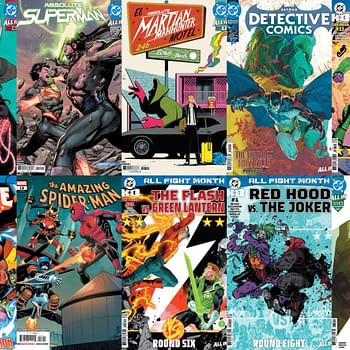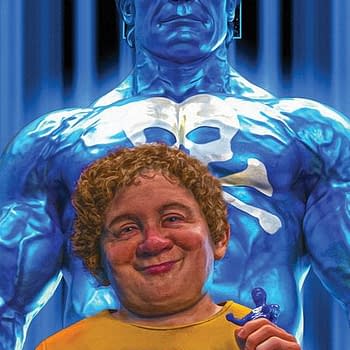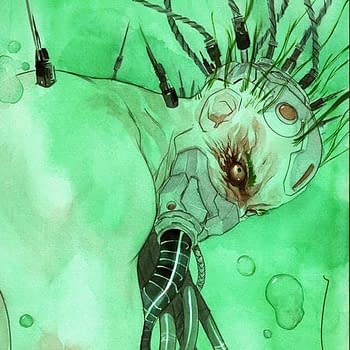Posted in: Comics | Tagged: 2016, Comics, dc, entertainment, Ethnocrunching, gendercrunching, image, june, marvel
Gendercrunching And Ethnocrunching Comics For June 2016 – Marvel, DC And Image
By Tim Hanley
Marvel's run of record highs took a downward turn in June, with DC's early days of "Rebirth" ticking them up enough to post the higher overall percentage of female creators for the month. June also marks our annual ethnicity tally, and we stop by DC, Marvel, and Image to see how things have changed over the past year.
DC COMICS
While DC put up only slight gains, it was enough to give them their best total since "Convergence" over a year ago. In June 2016, DC Comics put out 67 new comic books featuring 577 credited creators, 476 men and 101 women. Here are their numbers:
"Rebirth" started out relatively well for women at DC, with a gain of 0.6% female creators overall from May. While a small jump, DC's not been great with female creators during their past relaunches and revamps, so holding at a little more than steady is better than usual for them. However, the major creative numbers took a dip, with cover artists, writers, pencillers, and inkers all below their May numbers, including a whopping 8 point drop for female writers. Colorists and editorial ticked up slightly, while letterers and assistant editors each gained a few percentage points. The back end gains outweighed the front end losses just enough to raise the overall total a bit.
The Past Year At DC: With "Convergence" officially off the board now, the start of "Rebirth" marks DC's highest overall percentage of female creators in the past year:
DC's held steady for the past three months, an impressive feat in general and doubly so considering all of the new titles in June. Time will tell if "Rebirth" continues to do well for women at DC.
MARVEL COMICS
Marvel put out a ton of comics in June, but their overall percentage of female creators tumbled down. In June 2016, Marvel released a whopping 92 new books with 829 credited creators, 700 men and 129 women. Let's look at their stats:
Dropping 1.8% overall isn't disastrous, but it takes Marvel well below their recent highs and marks their second straight month of losses. Female pencillers rose slightly, colorists gained 4 points, and assistant editors picked up 3 points. The rest all fell (apart from Marvel's perpetual goose egg for female letterers), only a couple of points in most cases but editors dropped more than 6 points. The losses were enough to bring down the overall total, particularly the drop in female cover artists; Marvel's been hitting the variants hard as of late, and having fewer women doing covers carries a lot of weight.
The Past Year At Marvel: June's drop puts Marvel smack in the middle of their numbers over the past year; six months were higher and six were lower:
As always with Marvel, their new highs haven't lasted for long. However, their ups and downs nonetheless show an overall upward trajectory overall, so Marvel may be back on the rise soon.
ETHNICITY AT DC, MARVEL, AND IMAGE
We've mixed things up every June for the past few years and tabulated ethnicity along with gender, and we've seen similarly stark divisions. There are a lot of white dudes making comics in the direct market, unsurprisingly, but we saw hints of some interesting changes last year, so let's see where things stand now.
To create these stats, I listed all of the names in each publisher's solicits for June, which include the cover artists, writers, and interior artists (Image also lists colorists, but they weren't counted in order to keep Image the same as DC and Marvel). Because these numbers involve fewer categories, they aren't directly comparable to the overall percentages in our charts above; those include colorists, letters, and editorial, which the following charts do not. Ethnicity is very much about self-identification, of course, and I sought to find that above all else. Where that wasn't available, I gathered as much information about each creator as I could, relying on a combination of photos, names, and home countries to make this determination. The categories are very broad, owing to the fact that comics are predominantly white and if we broke the non-white categories down to more specific groups we couldn't even see them on the chart. Thus, "White" represents the many pale peoples of North American and European origin, "Hispanic" represents those of Central or South American origin, "Asian" accounts for roots in any part or the continent of Asia or the Pacific Islands, and "Black" covers people of African origin.
First up, let's look at DC Comics and their numbers for the past three Junes:
DC hasn't changed a lot over the past year. There were 0.3% fewer women in their June solicits, a drop so tiny as to be statistically insignificant. There were also 2.6% more white people, a more statistically insignificant change, though the ethnicity count involves a variety of judgement calls so there's more of a margin of error here. For the past three years, the number of white people at DC has been roughly steady, hovering around three quarters of their creators. Hispanic creators saw a bit of a jump in 2016, though, raising 4 percentage points, while the numbers for Asian and black creators both dropped to their lowest levels in the past three years. Across the board, DC's done little over the past year to improve representation in their creator ranks.
Now to Marvel, and their numbers from June 2014 through June 2016:
With their slew of female characters taking over the mantles of male heroes, Marvel's been rather self-congratulatory in the press lately when talking about representation. It's a little much given these numbers, but Marvel is certainly heading in a more representative direction at least. There were 6% more women in Marvel's solicits this year, a big gain from 2015; while 14% is still not a lot, it's certainly higher than 8%. Non-white creators were on the rise as well, particularly Asian and black creators, as Marvel's percentage of white creators dipped 8 points and hit the lowest level of all three publishers examined here. The numbers also show steady changes, with Marvel moving towards more representation for the last two years running.
Finally, let's look at gender and ethnicity at Image:
Image likes to set themselves up as the anti-Big Two, but there's little evidence for this in their creator ranks. Compared to their June 2015 numbers, the percentage of women at Image dropped by a third, while their ethnicity numbers barely changed at all. The ethnicity totals were technically slightly less representative, but not in any statistically significant way. All together, their percentages for women and combined non-white creators are lower than DC and Marvel's, by a fair amount.
Overall, we've got three publishers heading in different directions. Marvel is moving towards more representation for women and people of colour, DC is holding steady with women but overall dipping with non-white creators, and Image is doing worse with women and holding steady with creators of colour though their numbers there are the lowest of all three publishers. Added all together, the three publishers accounted for 83% of the comics sold through the direct market in June, and only 24% of the creators on those comics were people of colour while a tiny 11% were women. There remains a lot of room for each company to grow.
To learn more about this statistics project and its methodology click here, and to see the previous stats click here. You can visit Tim at Straitened Circumstances and follow him on Twitter @timhanley01. His first book Wonder Woman Unbound is available now, and his new book Investigating Lois Lane: The Turbulent History of the Daily Planet's Ace Reporter was released in March 2016.




















